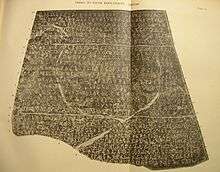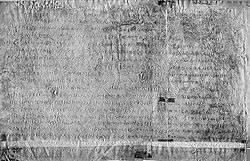Ashoka's Major Rock Edicts



Ashoka's Major Rock Edicts refer to 14 separate major Edicts of Ashoka which are significantly detailed and represent the earliest dated rock inscriptions of any Indian monarch.[1] For a full English translation of the Edicts:
History
Ashoka was the third monarch of the Mauryan dynasty in India, reigning from around 269 BCE.[2] Originally a Hindu Monarch, he famously converted to Buddhism and renounced violence soon after being victorious in a gruesome Kalinga War, yet filled with deep remorse for the bloodshed of the war. Although he was a major historical figure, little definitive information was known as there were few records of his reign until the 19th century when a large number of his edicts, inscribed on rocks and pillars, were found in India, Nepal, Pakistan and Afghanistan. In India, Places where rock edicts were found are – Kalsi, Uttarakhand; Sopara, Maharashtra; Mount Girnar, Gujarat; Yerragudi, Andhra Pradesh; Dhauli, Orissa; Jaugada, Orissa.These many edicts, of which Ashoka's Major Rock Edicts were the first and most impressive, were concerned with practical instructions in running a kingdom such as the design of irrigation systems and descriptions of Ashoka's beliefs in peaceful moral behavior. They contain little personal detail about his life.[2]
The list of Major Rock edicts[3]
Rock Edict I
Prohibits animal slaughter. Bans festive gatherings and killings of animals. Only two peacocks and one deer were killed in Asoka’s kitchen. He wished to discontinue this practice of killing two peacocks and one deer as well.
Major Rock Edict II
Provides for care for man and animals, describes about Chola, Pandyas, Satyapura and Keralputra Kingdoms of South India
Major Rock Edict III
Generosity to Brahmans. Issued after 12 years of Asoka’s coronation. It says that the Yuktas (subordinate officers and Pradesikas (district Heads) along with Rajukas (Rural officers ) shall go to the all areas of kingdom every five years and spread the Dhamma Policy of Asoka.
Major Rock Edict IV
Dhammaghosa is ideal to the mankind and not the Bherighosa. Impact of Dhamma on society.
Major Rock Edict V
Concerns about the policy towards slaves. He mentions in this rock edict ”Every Human is my child”. Appointment of Dhammamahamatras is mentioned in this edict.
Major Rock Edict VI
Describes King’s desire to get informed about the conditions of the people constantly. Talks about welfare measures.
Major Rock Edict VII
Requests tolerance for all religions - “To foster one’s own sect, depreciating the others out of affection for one’s own, to exalt its merit, is to do the worst harm to one’s own sect.”

Major Rock Edict VIII
Describes Asoka’s first Dhamma Yatra to Bodhgaya & Bodhi Tree.
Major Rock Edict IX
Condemns popular ceremonies. Stress in ceremonies of Dhamma.
Major Rock Edict X
Condemns the desire for fame and glory. Stresses on popularity of Dhamma.
Major Rock Edict XI
Elaborates Dhamma Major
Rock Edict XII
Directed and determined request for tolerance among different religious sects. Also writtten in Greek in the Kandahar Greek Edict of Ashoka (last portion)
Major Rock Edict XIII
It is the largest inscription from the edict. King considered the victory by "Dhamma" to be the foremost victory; mention the Dhamma victory on the Greek being named Antiochus;it also mentions the Dhamma victory over the following foreign brings- Ptolemy II Philadelphus- King of Egypt ( 285-247 BC) Alexander –King of Epirus (273-255 BC) Antigonous Gonatus- King of Macedonia ( 276-239 BC) Magas- King of Cyrene It also mentions the Dhamma victory in south over the Cholas and Pandyas as far as Ceylon Also writtten in Greek in the Kandahar Greek Edict of Ashoka (first portion)
Major Rock Edict XIV
Describes engraving of inscriptions in different parts of country.
Other Rock Edicts and inscriptions
Edicts at Kalinga, the place of epic war that transformed him.
Edict I : Asoka declared all people are my sons
Edict II : proclamation of edicts even to a single person.

Queen Edict
Mentions about second queen of Asoka
Barbara cave Inscription
Discusses giving away the Barbara cave to Ajivika sect Kandhar
Kandahar Bilingual Rock Inscription (Greek-Aramaic)
Expresses satisfaction over asokha’s policy
Pillar Edicts [4]
Asoka’s 7 pillar edicts have been found at Topra (Delhi), Meerut, Kausambhi, rampurva, Champaran, Mehrauli.
Minor pillar edicts have been found at Sanchi, Sarnath, Rummindei, Nigalisagar.
Pillar Edict I
Asoka’s principle of protection to people
Pillar Edict II
Defines dhamma as minimum of sins, many virtues, compassion, liberality, truthfulness and purity
Pillar Edict III
Abolishes sins of harshness, cruelty, anger, pride etc
Pillar Edict IV
Deals with duties of Rajukas
Pillar Edict V
List of animals and birds which should not be killed on some days and another list of animals which have not to be killed at all occasions. Describes release of 25 prisoners by Asoka.
Pillar Edict VI
Dhamma Policy Pillar Edict VII Works done by Asoka for Dhamma Policy. He says that all sects desire both self control and purity of mind.
Other Pillars
Rummindei Pillar Inscription
Asokha’s visit to Lumbini & exemption of Lumbini from tax.
Nigalisagar Pillar Inscription
It was originally located at Kapilvastu. It mentions that Asoka increased the height of stupa of Buddha Konakamana to its double size.
Language of Inscriptions
Three languages were used, Prakrit, Greek and Aramaic. Four scripts were used. The edicts are composed in non-standardized and archaic forms of Prakrit. Prakrit inscriptions were written in Brahmi and Kharosthi scripts, which even a commoner could read and understand. The inscriptions found in the area of Pakistan are in kharoshthi script. The rest are written in Greek or Aramaic. The Kandahar Rock Inscription is bilingual Greek-Aramaic.
Ashoka's edicts were the first written inscriptions in India after the ancient city of Harrapa fell to ruin. Ashoka's first edict is the only impressive edict remaining in its original state, since most of his other edicts were either dismantled and transported to places of national importance after their discovery or formalised into a national monument. Another rock edict of Ashoka in its original state is situated at Kalsi, near Vikas Nagar in Dehradun District of Uttranchal, India.[5]
Ashoka's edicts at Mount Girnar, Junagadh
Fourteen Edicts of Ashokha are inscribed on a large boulder that is housed in a small building located outside the town of Junagadh on Saurashtra peninsula in the state of Gujarat, India. It is located on Girnar Taleti road, at about 2 km (1.2 mi) far from Uperkot Fort easterly, some 2 km before Girnar Taleti. An uneven rock, with a circumference of seven meters and a height of ten meters, bears inscriptions etched with an iron pen in Brahmi script in a language similar to Pali and date back to 250 BCE, thus marking the beginning of written history of Junagadh.[6])
On the same rock there are inscriptions in Sanskrit added around 150 CE by Mahakshatrap Rudradaman I, the Saka (Scythian) ruler of Malwa, a member of the Western Satraps dynasty.[6] The edict also narrates the story of Sudarshan Lake which was built / renovated by Rudradaman I, and the heavy rain and storm due to which it had broken.
Another inscription dates from about 450 CE and refers to Skandagupta, the last Gupta Empire.
The protective building around the edicts was built in 1900 by Nawab Rasool Khan of Junagadh State at a cost of Rs 8,662. It was repaired and restored in 1939 and 1941 by the rulers of Junagadh. The wall of the structure was collapsed in 2014.[7]
Of note, A much smaller replica of these Girnar edicts have been positioned outside the entrance of the National Museum in Delhi.
Content
.jpg)
The Major Rock Edict at Girnar includes Ashoka's first rock edict, and reads as follows: "The King, King Piyadasi, has caused this Dhamma edict to be written. Here (in my domain) no living beings are to be slaughtered or offered in sacrifice. Nor should festivals be held, for Beloved-of-the-Gods, King Piyadasi, sees much to object to in such festivals, although there are some festivals that Beloved-of-the-Gods, King Piyadasi, does approve of."
- Formerly, in the kitchen of Beloved-of-the-Gods, King Piyadasi, hundreds of thousands of animals were killed every day to make curry. But now with the writing of this Dhamma edict only three creatures, two peacocks and a deer are killed, and the deer not always. And in time, not even these three creatures will be killed."[2]
References
- ↑ "This excerpt from a new book demolishes Emperor Ashoka's reputation as a pacifist".
- 1 2 3 "The Edicts of King Ashoka". Archived from the original on 14 March 2007. Retrieved 2007-03-15.
- ↑ http://www.gktoday.in/asokas-edicts-inscriptions/#Major_Rock_Edict_XIV
- ↑ http://www.gktoday.in/asokas-edicts-inscriptions/#Major_Rock_Edict_XIV
- ↑ "The Life Of Ashoka Mauryan - His legacy". Archived from the original on 5 April 2007. Retrieved 2007-03-15.
- 1 2 Keay, John (2000). India, a History. New York, United States: Harper Collins Publishers. pp. 129–131. ISBN 0-00-638784-5.)
- ↑ "Roof over Ashoka rock edicts in Junagadh crashes". The Times of India. 19 July 2014. Retrieved 21 March 2016.
External links
| Wikimedia Commons has media related to Ashoka Major Rock Edict, Girnar. |